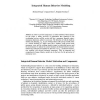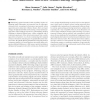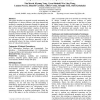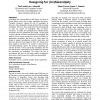13 search results - page 2 / 3 » Analysis of human interruptibility in the home environment |
EICS
2009
ACM
13 years 8 months ago
2009
ACM
This paper presents an approach for investigating in a predictive way potential disruptive effects of interruptions on task performance in a multitasking environment. The approach...
DAGSTUHL
2007
13 years 6 months ago
2007
In order to prevent emergencies or critical situations where humans are the origin, a timely provision of information thus obtained for the coordinating services and the on-site st...
JOCN
2010
12 years 11 months ago
2010
Maintaining spatial orientation while travelling requires integrating spatial information encountered from an egocentric viewpoint with accumulated information represented within ...
CHI
2005
ACM
14 years 5 months ago
2005
ACM
This paper describes an approach towards automating the identification of design problems with three-dimensional mediated or gaming environments through the capture and query of u...
CANDC
2009
ACM
13 years 11 months ago
2009
ACM
Serendipity has a long tradition in the history of science as having played a key role in many significant discoveries. Computer scientists, valuing the role of serendipity in dis...




